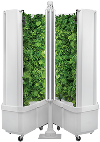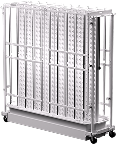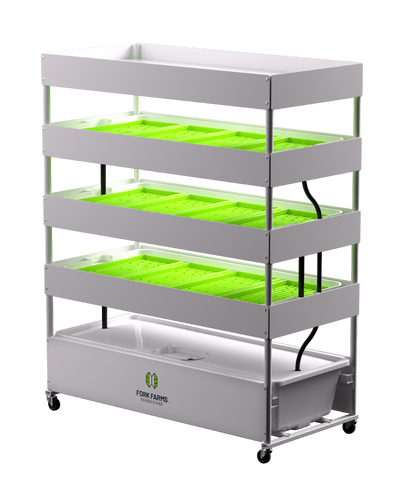Is An Indoor Vegetable Garden Easy To Maintain?
All over the world, people are turning to indoor vegetable gardening. With numerous benefits, including better control over growing conditions, the ability to extend the growing season, and sustainability, indoor gardening offers a viable and rewarding way to grow fresh produce. From urban gardens or restaurants to community organizations, successful indoor vegetable gardens can be a game changer.
How Easy is it to Take Care of an Indoor Garden?
The short answer is yes - maintaining an indoor vegetable garden can be both easy and rewarding! Of course, like any new hobby or skill, there’s a learning curve, and growers need to pay close attention to detail and consistently care for their indoor garden. In our experience, here are the key factors to consider when starting an indoor vegetable garden:
Suitable and Reliable Light For Your Indoor Garden
On average, most vegetables need at least 6-8 hours of sunlight daily. For indoor gardens, this means that spaces need to have a way of providing natural or artificial light. For natural light, windows (such as south-facing) can be the answer. If an indoor space does not have good access to natural lighting, the most effective type of lighting is LED grow lights.
These types of lights ensure that plants get the kind of energy they need, all while:
- Maintaining energy efficiency and consuming less power.
- Being more cost-effective, as lights may need to be on for long periods.
- Providing a full spectrum of light to promote growth.
- Emitting less heat, resulting in less damage to plants.
- Having a long lifespan and needing to be replaced less often.
- Coming in various sizes and configurations.
Growers can configure their gardens with a DIY approach to lighting or invest in a vertical system, such as a hydroponic gardening system that comes with customized lights.
Indoor Plants Need The Right Growth System
When growing indoors, it’s crucial to choose the right growth system. Traditionally, this has been a combination of soil and containers, such as:
- Potting soil that is specifically formulated for indoor container gardening.
- Garden soil, although it may contain pests, diseases, and weed seeds that can harm indoor plants. Garden soil also compacts in containers, leading to poor drainage and root aeration.
- Worm castings are a rich source of nutrients and beneficial microbes that can enhance plant growth. Coconut coir is also a sustainable alternative to peat moss and may improve moisture retention and aeration.
For containers, pots with drainage holes can prevent waterlogged soil, as long as the container matches the vegetable's root depth requirements.
For example:
- Tomatoes: Require a 5-10 gallon pot, as tomatoes have an extensive root system.
- Lettuce: Only need to grow in a 6-12 inch pot.
- Carrots: Need an 8-inch deep pot to allow their roots to grow downward.
- Herbs: Herbs tend to be smaller and do well in a 6-inch pot.
However, with the unpredictability that can come with growing with soil, manygrowers are bypassing it entirely. Instead, growers are looking at indoor hydroponic systems. Hydroponic systems, well-suited for indoor environments, use nutrient-rich water solutions in place of soil. A few advantages to indoor hydroponics include:
- Hydroponic systems use less water compared to traditional soil gardening.
- Indoor hydroponic systems use LED grow lights, allowing plants to effectively grow indoors.
- Hydroponic systems use a water circulation mechanism to give roots adequate oxygen, promoting faster and healthier plant growth.
Due to the direct access to nutrients and controlled growing conditions, plants grown hydroponically often grow faster than those grown in soil. These systems also support a wide range of plants, including herbs, vegetables, and fruits.
Ongoing Air Circulation and Temperature Control
Good air circulation is a critical aspect of maintaining a healthy indoor vegetable garden. Mold, mildew, and pests can thrive in stagnant air, making it challenging to grow healthy plants.
Here are the best practices for improving air circulation in an indoor garden:
- Invest in fans, as small oscillating fans or clip-on fans can be easily positioned to direct airflow around plants. In larger indoor gardens or grow tents, consider using exhaust fans to remove stale air and bring in fresh air. Intake vents or openings can also be used to allow fresh air to enter the growing area.
- Space plants appropriately to avoid overcrowding, as it can create microenvironments where mold and pests can thrive.
- Regularly prune plants to remove excess foliage and improve airflow around the remaining leaves and stems.
When it comes to temperature control, it’s important to know the type of environment a plant is being grown in, even indoors. From there, depending on whether they are using a hydroponic system or soil, growers should consider investing in tools such as:
- A hygrometer to monitor humidity and adjust as needed. Most indoor vegetables thrive in humidity levels between 40-60%.
- In high-humidity environments, a dehumidifier can help reduce moisture levels and prevent mold and mildew growth.
- Fans can also help maintain a consistent temperature in an indoor space.
Another important factor is to keep the growing area clean and free of debris. If not maintained, an unclean indoor garden can harbor pests and diseases. Clean fans, ventilation equipment, and dehumidifiers regularly to ensure they operate effectively.
Getting Started with Indoor Vegetable Gardens
With the right setup, an indoor vegetable garden is relatively easy to maintain. By paying attention to light, water, and other environmental factors, growers can enjoy fresh, homegrown vegetables year-round. As the success of growing fresh vegetables relies heavily on consistency, many growers choose to invest in a ready-to-go hydroponics system built specifically for growing veggies indoors.
The Flex Farm, for instance, is portable and only requires a standard electrical outlet and less than 10 square feet of space. The easy-to-use system also only requires about 2 hours of regular maintenance per month.
Want to learn more about working with a hydroponic system? Learn more about our Flex Farm system today!
Important Links:
























